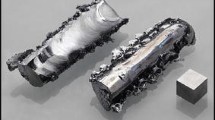Summary
Reaction of CO2 with [Mo(N2)2Ph2PCH2CH2PPh2] in PhMe at room temperature produces a material which analyses for [Mo(CO2)2(Ph2PCH2CH2PPh2)2], and which may be a bis(carbon dioxide) complex.
The recent description(1) of a CO2 complex of molybdenum, namely [Mo(CO2)2(PMe3)4], prompts us to report a homologous compound [Mo(CO2)2(Ph2PCH2CH2PPh2)2], which we isolated from the reaction of CO2 and [Mo(N2)2(Ph2PCH2CH2PPh2)2] at room temperature under tungsten-filament irradiation. The similar reaction in PhMe at reflux produces [Mo(CO)2(Ph2PCH2CH2PPh2)2](2).
The yellow crystalline compound was isolated as a THF solvate inca. 75% yield and is air-stable. The i.r. spectrum contains a strong band in the 1695–1710 cm−1 region, associated with the CO2, which compares with the 1670 cm−1 band reported(1) for [Mo(CO2)2(PMe3)4] and a band at 1760 cm−1 found for [Mo(CO2)2(PMe2Ph)4](3).
The diamagnetic compound has not yet provided crystals suitable for x-ray analysis. Consequently, we were not able to determine whether this is a genuine CO2 complex or whether the two CO2 molecules have combined head-to-tail, as found for [Ir(C2O4)Cl(PMe3)3](4). The31P {1H} n.m.r. spectrum shows a pair of asymmetric doublets centred atca. 108 and 78 p.p.m. downfield from (MeO)3P. This suggests that the phosphoruses are no longer equivalent. The13C {1H n.m.r. spectrum has a broad resonance at 27.1 p.p.m. downfield from TMS, which may arise from the bound CO2 in whatever form it may be.
Reactions with acids and oxidising agents did not give conclusive results. Thus treatment with Br2 (4 moles) in C6H6 yields CO (1 mole) and CO2 (1 mole); H2SO4 and HCl in C6H6 produced CO2 (1 mole), as does neat CCl4. The most convincing experiment was the reaction with MeNC, which was carried out in THF under reflux in a closed system. Two moles of CO2 were evolved, and the complex product was the known material(5) [Mo(CNMe)2(Ph2PCH2CH2PPh2)2], formed in quantitative yield.
We think that this material is probably a bis(carbon dioxide) complex, its stability arising from the lack of dissociation of the two diphosphine ligands, but we cannot exclude the possibility of head-to-tail ring(4). We observed no reactions with CO, H2, MeBr or P(O2CH2)3CMe, but Ph2PCH2CH2PPh2 in C6H6 under reflux produces CO2 (1 mole).
Carbon dioxide in THF under irradiation reacts only slowly with [W(N2)2(PMe2Ph)4] and [W(N2)2(Ph2PCH2PPh2)2]; no products have been identified.
Similar content being viewed by others
References
E. Carmona, F. Gonzalez, M. L. Poveda, J. M. Mann, J. L. Atwood and R. D. Rogers,J. Am. Chem. Soc., 105, 3365 (1983).
T. Ito, T. Kokubo, T. Yamamoto, A. Yamamoto and S. Ikeda,J. Chem. Soc., Chem. Commun., 136 (1974).
J. Chatt, M. Kubota, G. J. Leigh, F. C. March, R. Mason and D. J. Yarrow,J. Chem. Soc., Chem. Commun., 1033 (1974).
T. Herskovitz and L. J. Guggenberger,J. Am. Chem. Soc., 98, 1615 (1976).
J. Chatt, C. M. Elson, A. J. L. Pombeiro, R. L. Richards and G. H. D. Royston,J. Chem. Soc., Dalton Trans., 165 (1978).
Author information
Authors and Affiliations
Rights and permissions
About this article
Cite this article
Chatt, J., Hussain, W. & Leigh, G.J. A possible bis(carbon dioxide) adduct of molybdenum(0). Transition Met Chem 8, 383–384 (1983). https://doi.org/10.1007/BF00618580
Received:
Issue Date:
DOI: https://doi.org/10.1007/BF00618580




